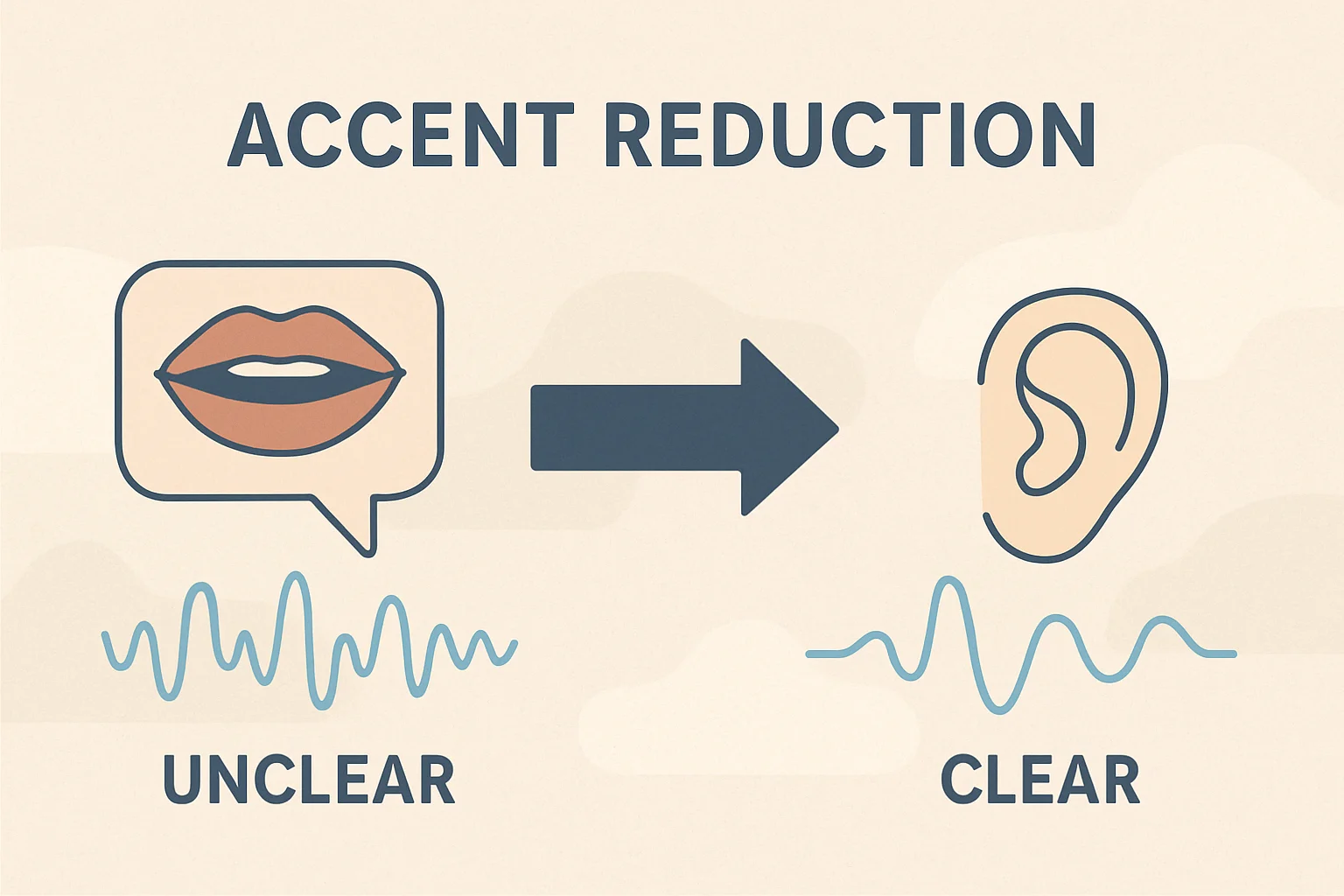How to Lose Turkish Accent: A Practical Guide to Clearer English Communication

You’ve mastered English grammar. Your vocabulary is impressive. You can write emails and reports with confidence. Yet when you speak, you still see that slight confusion in people’s eyes, or hear those dreaded words: “Could you repeat that, please?”
One of the main challenges is overcoming a foreign accent, which can be difficult due to ingrained speech habits and unique pronunciation patterns from your native language.
As someone who has worked with hundreds of Turkish professionals seeking to improve their English pronunciation, I understand the unique challenges you face. Your Turkish accent carries the beautiful melody of your native language, but in professional settings, you want to be understood clearly the first time.
The good news? Accent reduction for speakers of Turkish is absolutely achievable with the right approach. This guide will walk you through practical, proven techniques specifically designed to address the unique patterns of Turkish-accented English, helping you communicate with greater clarity and confidence.

Introduction to Accent Reduction
Accent reduction is a process of modifying one’s accent to sound more like a native speaker of a target language, such as English. This can be particularly beneficial for non-native speakers who want to improve their communication skills and be better understood by native speakers.
Accent reduction involves learning the correct pronunciation, intonation, and rhythm of the target language. It also requires consistent practice in speaking and listening to native speakers. By focusing on these elements, non-native speakers can significantly improve their pronunciation and reduce their accent, leading to clearer and more effective communication.
Understanding Turkish-Accented English: The Foundation for Change
Before diving into techniques for Turkish accent reduction, it’s helpful to understand why certain English sounds and patterns are challenging for native Turkish speakers.
Turkish and English have fundamentally different phonological systems—different sounds, syllable structures, and rhythm patterns. These differences create predictable patterns in Turkish-accented English that we can systematically address. For instance, Turkish pronunciation often struggles with the distinct ‘R’ and ‘W’ sounds in English, which can be particularly challenging for Turkish speakers to articulate correctly.
Understanding Accents and Their Significance
Accents are a natural part of language and can vary greatly from one region to another. They are shaped by a combination of factors, including geographical location, cultural background, and social environment. Understanding accents and their significance is essential for effective communication, especially in a globalized world where people from different countries and cultures interact with each other.
By recognizing and appreciating the diversity of accents, we can foster mutual understanding and respect among people from different linguistic backgrounds. This mutual understanding is crucial for building strong, respectful relationships in both personal and professional settings.

Key Differences Between Turkish and English Sound Systems
Vowel Differences:
- Turkish has 8 vowel sounds with strict vowel harmony rules
- English has 14-20 vowel sounds (depending on the dialect) with no vowel harmony
- Turkish lacks several English vowel distinctions (like the difference between “ship” and “sheep”)
- Turkish speakers often face challenges with English vowels due to the differences in vowel systems between the two languages, making it essential to focus on mastering these specific English vowel sounds to improve pronunciation skills.
Consonant Challenges:
- Turkish lacks several English consonants, including “th” (both voiced as in “this” and unvoiced as in “think”), “w”, and the distinct “v” sound
- Turkish has different rules for consonant clusters, often leading to vowel insertion between consonants in English
Syllable Structure:
- Turkish words typically follow vowel-consonant alternation
- English allows complex consonant clusters (e.g., “strengths”)
Rhythm and Stress:
- Turkish is a syllable-timed language where each syllable receives roughly equal emphasis
- English is stress-timed, with significant contrast between stressed and unstressed syllables
Word Stress Placement:
- Turkish words are typically stressed on the last or penultimate syllable
- English word stress follows complex patterns that must be learned individually
Understanding these structural differences explains why certain English sounds and patterns feel challenging—it’s not about ability but simply different linguistic programming.

Common Patterns in Turkish-Accented English
When focusing on accent reduction for speakers of Turkish, these are the specific patterns that most frequently affect clarity:
Turkish speakers often struggle with the word-final ‘d’ sound in English, finding it challenging to articulate correctly and to distinguish it from the ‘T’ sound. Practical exercises focusing on words ending with ‘d’ can help learners master this sound, emphasizing the voiced quality the ‘D’ sound requires in final positions.
Vowel Distinctions
Turkish pattern: Not distinguishing between long and short vowels (“ship” sounds like “sheep”)
Clear English: Maintaining appropriate vowel length distinctions
Turkish pattern: Adding vowels between consonant clusters (“street” becomes “sitreet”)
Clear English: Smooth transition between consonants without added vowels
Consonant Challenges
Turkish pattern: “Th” becomes “t,” “d,” or “s” (“tink” instead of “think”)
Clear English: Placing the tongue between the teeth for “th” sounds
Turkish pattern: “W” becomes “v” (“very” instead of “wery”)
Clear English: Rounding lips without lower lip touching teeth
Turkish pattern: Final consonants often devoiced (“bad” sounds like “bat”)
Clear English: Maintaining voiced quality in final consonants
Word Stress
Turkish pattern: Stress placed on the final or penultimate syllable
Clear English: Varied stress patterns specific to English words
Intonation Patterns
Turkish pattern: Narrower pitch range with rising intonation
Clear English: Wider pitch range with specific patterns for statements vs. questions
By targeting these specific patterns, you’ll make rapid progress in your Turkish accent reduction journey.

A Step-by-Step Approach to Turkish Accent Reduction
Now let’s explore a systematic approach to modifying these accent patterns: Regular practice and imitation of native speakers are essential components in the process of reducing accents.
Consistent engagement with audio samples and interactive exercises enhances pronunciation skills, leading to a more authentic and natural speaking style.
Step 1: Train Your Ear to English Sounds
Before you can change your pronunciation, you need to train your ear to hear the differences between your current patterns and your target sounds.
Daily listening exercises:
- Listen to English podcasts, TED talks, or newscasts
- Pay attention to the rhythm and stress patterns of native speakers
- Focus on sounds that don’t exist in Turkish (like “th” and “w”)
- Notice how words connect in fluent speech
- Be aware of words that sound similar to avoid misunderstandings
Spend 10-15 minutes daily on focused listening. I recommend choosing a short audio clip (30-60 seconds) and listening to it repeatedly, gradually noticing more details each time.
Step 2: Master the Physical Elements of Pronunciation
Understanding the physical positioning of your articulators (tongue, lips, jaw) is crucial for Turkish accent reduction. Learning how to pronounce English sounds correctly is essential for effective communication and understanding.
For the “Th” sounds:
- Place the tip of your tongue between your teeth (not behind them as in Turkish)
- For the unvoiced “th” (as in “think”), blow air gently between your tongue and teeth
- For the voiced “th” (as in “this”), add voice while your tongue is between your teeth
- Practice words like “think,” “thank,” “this,” and “them”
For the “W” sound:
- Round your lips into a tight circle
- Do not let your bottom lip touch your upper teeth (as in the “v” sound)
- Keep the back of your tongue raised slightly
- Practice words like “way,” “when,” and “why”
For the short/long vowel distinctions:
- For short vowels (as in “ship”), make a quick, tense sound
- For long vowels (as in “sheep”), relax your jaw and extend the sound
- Practice minimal pairs: “ship/sheep,” “bit/beat,” “full/fool”
Step 3: Use the Record, Listen, Repeat Method
One of the most effective techniques for accent reduction for speakers of Turkish is the record-and-compare approach:
- Choose a short audio clip (30-60 seconds) of a native English speaker
- Record yourself reading the same text
- Compare your pronunciation to the original
- Identify specific differences in individual sounds, stress patterns, and intonation
- Re-record yourself focusing on those specific elements
- Repeat this process regularly with the same text to track improvement
Mastering correct pronunciations through the record, listen, repeat method is crucial for achieving a more authentic speaking style and navigating the complexities of English pronunciation.
This method provides objective feedback on your progress and helps you focus on the most important areas for improvement.

Step 4: Practice Minimal Pairs and Targeted Word Lists
Focused practice with minimal pairs (words that differ by just one sound) is extremely effective. Practicing specific words is crucial for mastering pronunciation and understanding accents:
Th/T pairs:
- “think” vs. “tink”
- “thumb” vs. “tum”
- “path” vs. “pat”
Th/D pairs:
- “they” vs. “day”
- “those” vs. “doze”
- “breathe” vs. “breed”
W/V pairs:
- “wine” vs. “vine”
- “west” vs. “vest”
- “away” vs. “ave”
Short/Long Vowel pairs:
- “ship” vs. “sheep”
- “hit” vs. “heat”
- “pull” vs. “pool”
Practice these pairs daily, recording yourself and listening for the distinctions.
Step 5: Master English Rhythm and Stress
After addressing individual sounds, focus on the musical patterns of English:
Word stress exercises:
- Mark the stressed syllables in multi-syllabic words
- Exaggerate the stressed syllables and reduce the unstressed ones
- Practice word families that shift stress:
- PHOtograph, phoTOGraphy, photoGRAPHic
- DEMocrat, deMOcracy, demoGRAPHic
Sentence rhythm practice:
- Study content words (nouns, verbs, adjectives) vs. function words (articles, prepositions)
- Practice emphasizing content words while reducing function words
- Use rubber bands or hand movements to physically feel the stretching and compression of stress patterns
This step is often overlooked in Turkish accent reduction, but it dramatically improves the natural flow of your English. Developing a more authentic English accent through mastering rhythm and stress is crucial for mimicking native speakers and reducing foreign accents.

Step 6: Practice Consonant Clusters
Since Turkish often adds vowels between consonants, this area needs special attention:
- Practice words with initial consonant clusters: “street,” “spring,” “script”
- Practice words with final consonant clusters: “desks,” “texts,” “helps”
- Start slowly, focusing on making a smooth transition between consonants without inserting vowels
- Gradually increase your speed while maintaining accuracy
It is crucial to ensure that these consonant clusters are correctly pronounced to avoid misunderstandings and to improve overall fluency.
Step 7: Apply Your Skills in Contextual Practice
Once you’ve made progress on individual elements, practice combining them:
- Read aloud from news articles, focusing on maintaining correct pronunciation throughout
- Record yourself having a one-sided conversation on a topic in your field
- Practice explaining complex concepts, focusing on clarity
- Role-play common professional scenarios (presentations, meetings, interviews)
This contextual practice helps you transfer your improved pronunciation to real-world situations and apply your language skills effectively.
Practical Exercises for Daily Turkish Accent Reduction
Consistent daily practice is the key to successful accent reduction for speakers of Turkish. Learning and practicing new words is crucial for improving language skills and reducing accents. Here are exercises you can incorporate into your routine:
Tongue Twisters for Problematic Sounds
For TH sounds:
- “The thirty-three thieves thought thoroughly Thursday through”
- “They thanked the other three for thinking thoughtfully”
For W/V distinction:
- “Wayne went west where William was waiting”
- “We were very worried about the wet weather”
For Consonant Clusters:
- “Strict strong strings stretch strangely”
- “Fresh fried fly and french fries”
Start slowly and gradually increase your speed while maintaining accuracy. Tongue twisters can be particularly challenging for native Turkish speakers due to the difficulties in distinguishing between English sounds represented by the same single letter in Turkish.

Shadow Reading
Shadowing involves listening to native speech and repeating it with minimal delay:
- Choose audio with a speaker whose voice and pace you can reasonably match
- Listen to a short phrase
- Repeat it immediately, mimicking not just the words but the exact intonation and rhythm
- Gradually decrease the gap until you’re speaking almost simultaneously with the recording
This technique helps you internalize natural speech patterns while improving specific sounds. For a more effective approach, consider following a comprehensive guide to accent reduction, which offers a thorough overview of techniques and strategies tailored to specific language learners.
Targeted Script Practice
Develop realistic scripts for situations where clear communication is particularly important:
- Professional introductions
- Technical explanations relevant to your field
- Phone calls and video conferences
- Common work conversations
Practice these scripts until they feel natural, focusing on the specific sounds and patterns you’ve been working on. Additionally, emphasize the importance of selecting a specific accent to master, as this helps in replacing your existing accent and adapting to the nuances of the target language.
Improving Communication Skills
Improving communication skills is a key aspect of accent reduction. This involves developing the ability to express oneself clearly and effectively in the target language, taking into account the nuances of pronunciation, grammar, and vocabulary.
Non-native speakers can improve their communication skills by practicing speaking and listening to native speakers, using online resources and language learning apps, and seeking feedback from language teachers or tutors.
Consistent practice and targeted exercises can significantly aid in improving communication skills and reducing accents. By focusing on these areas, non-native speakers can enhance their ability to communicate clearly and confidently in English.
Using Spelling to Improve Pronunciation
Using spelling to improve pronunciation is a valuable technique for non-native speakers. By learning the phonetic symbols and pronunciation guides associated with English words, learners can improve their pronunciation and reduce their accent. This involves paying attention to the relationship between letters and sounds, as well as practicing the correct pronunciation of words.
Online resources and language learning apps can provide valuable insights and practical tips for using spelling to improve pronunciation. By incorporating these tools into their practice routine, learners can make significant progress in their accent reduction journey.
Seeking Feedback and Support
Seeking feedback and support is an essential part of the accent reduction process. Non-native speakers can benefit from working with a language teacher or tutor who can provide personalized feedback and guidance on pronunciation, grammar, and vocabulary.
Additionally, practicing with native speakers, either in person or online, can help learners improve their communication skills and reduce their accent. Many online resources and language learning apps also offer speech recognition features and feedback tools to help learners track their progress and identify areas for improvement.
By seeking feedback and support, non-native speakers can accelerate their progress and achieve their goals in accent reduction.
How Long Does Turkish Accent Reduction Take?
The timeline for improving your English pronunciation depends on several factors, but here’s what most of my Turkish clients experience:
- First noticeable improvements: 2-4 weeks of consistent practice
- Significant reduction in misunderstandings: 2-3 months
- Comfortable, clearer pronunciation: 3-6 months
- Natural-sounding speech in various situations: 6-12 months
Accent reduction not only enhances professional opportunities but also leads to improved understanding in diverse linguistic communities, fostering meaningful connections across cultures.
Factors that influence your timeline include:
- Your current English proficiency
- How many hours you speak English weekly
- Your daily practice consistency (the most crucial factor)
- The quality of your feedback
- Which specific patterns are most prominent in your speech
Remember that consistency is more important than intensity. Fifteen minutes of daily practice will yield better results than occasional longer sessions.
Self-Practice vs. Working with an Accent Coach
As you pursue Turkish accent reduction, you’ll need to decide whether to use self-practice resources, take a dedicated course for structured learning, or work with a professional coach.
Self-Practice Approach
Several self-study resources can help you make progress:
- YouTube channels dedicated to pronunciation
- Apps like ELSA Speak or Speechling
- Online courses focused on pronunciation
- Mirror work with tutorial videos
Learning a foreign language through self-practice can be particularly challenging due to the need for regular practice, immersion, and focusing on pronunciation.
The DIY approach works best when you:
- Have a good ear for sound distinctions
- Can motivate yourself to practice consistently
- Are able to monitor and correct your own pronunciation

Benefits of Professional Coaching
Working with an accent coach offers several distinct advantages:
- Expert assessment of your specific speech patterns
- Real-time feedback and correction before incorrect habits form
- Customized exercises targeting your unique challenges
- Accountability and structured progression
- Strategies for applying new patterns to real-world situations
For a native Turkish speaker, mastering English pronunciation can be particularly challenging due to nuanced sounds and consonant clusters. A specialized platform designed to assist Turkish speakers can be highly beneficial in refining their English skills.
Consider working with a coach if:
- You’ve tried self-study but keep making the same mistakes
- You can’t hear certain sound distinctions
- You want to accelerate your progress
- You need accountability to maintain consistent practice
- You want a personalized approach tailored to your specific patterns
The most effective approach often combines initial coaching to establish correct patterns with self-practice between sessions.
Success Stories: Turkish Professionals Who Transformed Their Communication
Let me share a few examples of how Turkish speakers have successfully modified their accents:
Mehmet, Software Engineer: Mehmet struggled during team meetings, often finding his technical insights overlooked because colleagues had trouble understanding him. After focusing on consonant clusters and word stress for just two months, he transformed his communication. “Now my colleagues understand me the first time,” he says. “I’m able to contribute my ideas fully without the frustration of repeating myself.”
Ayşe, Marketing Executive: Ayşe was hesitant to lead client calls despite her exceptional marketing expertise. By focusing on the “th” sounds and English rhythm patterns, she developed a much clearer speaking style. “My confidence has completely changed,” she reports. “Clients focus on my strategies rather than struggling to follow my pronunciation.”
Emre, University Researcher: Emre worried that his accent was limiting his effectiveness when presenting at international conferences. After just six weeks of focused work on vowel distinctions and intonation, he noticed a significant difference in audience engagement. “I no longer see that confused look during my presentations,” he shares. “People are asking about my research methodology instead of asking me to repeat myself.”
These success stories demonstrate how targeted Turkish accent reduction techniques, including mastering the American accent, can create meaningful improvements in a relatively short time.
Maintaining Your Identity While Reducing Your Accent
Many Turkish speakers worry that modifying their accent somehow means sacrificing their cultural identity. This concern is completely understandable.
The truth is that accent modification is about adding communication options, not subtracting from your identity. Think of it like having different registers in your native language—formal speech for professional settings, casual speech with friends. You’re developing the ability to communicate more clearly in specific contexts while remaining authentically yourself. Maintaining your mother tongue while reducing your accent ensures that your cultural identity remains intact.
Many successful Turkish professionals maintain their accent in personal settings while shifting to clearer pronunciation in professional contexts. This flexibility is a valuable skill, not a rejection of heritage.
The goal isn’t to “erase” your Turkish identity but to ensure your brilliant ideas are understood the first time.
Next Steps: Your Path to Clearer English Communication
Now that you understand the process for Turkish accent reduction, here are the first steps you can take:
- Assess your current patterns: Record yourself speaking English and identify which patterns from this article are most prominent in your speech
- Train your ear: Spend 10-15 minutes daily listening to native English speakers, focusing on the elements that differ from your speech
- Learn correct mouth positions: Practice the specific tongue and lip positions for challenging sounds like “th,” “w,” and vowel distinctions
- Focus on rhythm and stress: Practice emphasizing the correct syllables in words and using appropriate intonation in sentences
- Get expert guidance: Consider a professional assessment to identify your specific challenges and create a targeted plan
Remember that English is spoken with many accents, and understanding these regional nuances can significantly enhance your fluency and cultural understanding. Accent modification is a skill development process, not an overnight transformation. With consistent practice and the right guidance, you can dramatically improve your English pronunciation clarity while maintaining your authentic voice.
If you’re ready to take the next step in your Turkish accent reduction journey, I offer personalized assessments to identify exactly which aspects of your speech would benefit most from modification and create a customized plan for your specific needs.
Schedule Your Free Accent Assessment Today!

Frequently Asked Questions About Turkish Accent Reduction
Is it possible to completely eliminate my Turkish accent?
While complete accent elimination is rare, you can certainly reduce it to the point where it no longer creates communication barriers. Most Turkish speakers can develop pronunciation that is easily understood by native English speakers with a few months of focused practice. Rather than aiming for “no accent,” focus on clear communication as your goal.
At what age is it too late to reduce my accent?
It’s never too late! While children typically acquire new sounds more easily, adults of all ages can make significant improvements in their pronunciation. I’ve worked with clients in their 50s and 60s who have successfully reduced their Turkish accents. Neuroplasticity continues throughout life, allowing you to form new speech habits at any age. Additionally, the influence of one’s first language plays a crucial role in accent reduction, as it shapes the way we pronounce and understand new sounds.
What’s the hardest English sound for Turkish speakers?
While individual challenges vary, most Turkish speakers find the “th” sounds (both voiced and unvoiced), the distinction between “w” and “v,” and certain vowel distinctions most challenging. The rhythm and stress patterns of English also present significant difficulties since they differ fundamentally from Turkish. Additionally, the ‘NG’ sound in English does not exist in the Turkish language, making it particularly challenging for Turkish speakers to pronounce.
Should I learn American or British English pronunciation?
Choose the variety you’ll use most often in your daily life or professional context. If you work primarily with Americans or plan to live in the US, focus on American pronunciation. If you interact mostly with British English speakers, prioritize those patterns. The key is consistency—mixing the two can create confusion. Understanding different dialects and accents, such as American English and its variations, can enhance your learning experience and facilitate better communication in the English-speaking world.
How can I practice if I don’t have many opportunities to speak English?
Create practice opportunities even when you’re alone:
- Read aloud for 10-15 minutes daily
- Have conversations with yourself about your day
- Record and listen to yourself
- Join online language exchange communities
- Find a conversation partner through apps like Tandem or HelloTalk
- Participate in virtual meetups for English practice
Practicing multiple languages can enhance your ability to adapt to different accents and dialects, which is crucial for effective communication.
Even without regular conversation partners, consistent solo practice can lead to significant improvements in your Turkish accent reduction journey.

